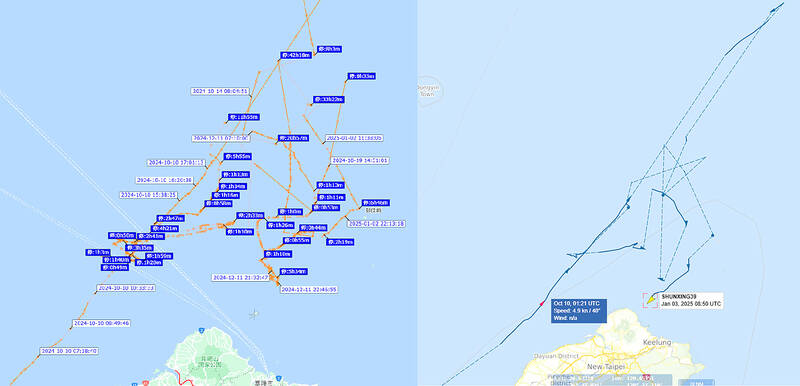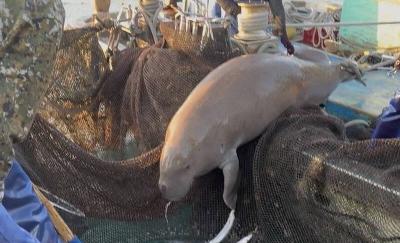A Chinese cargo ship repeatedly intruded into Taiwan’s contiguous and sovereign waters for three months before allegedly damaging an undersea Internet cable off Kaohsiung, a Liberty Times (sister paper of the Taipei Times) investigation revealed.
Using publicly available information, the Liberty Times was able to reconstruct the Shunxing-39’s movements near Taiwan since Double Ten National Day last year.
Taiwanese officials did not respond to the freighter’s intrusions until Friday last week, when the ship, registered in Cameroon and Tanzania, turned off its automatic identification system shortly before damage was inflicted to a key cable linking Taiwan to the rest of the world.

Photo: Courtesy of HiFleet and Vessel Finder
The owners of the Shunxing-39 in November last year retroactively declared that the ship on Sept. 28 had departed from South Korea’s Busan for the Port of Keelung, according to China-based My Ship Tracking.
Keelung had no record of the freighter’s arrival.
The China-based HiFleet showed that the Shunxing-39 transited the Taiwan Strait on Sept. 28 and moved toward China’s Guangdong Province without approaching Keelung.
The ship did not stop in any ports before returning to its unknown point of origin.
Records from ship trackers indicated that the freighter on Oct. 10 entered the northern bounds of Taiwan’s contiguous zone, which is 24 nautical miles (44km) from its coast, sporadically deactivating its automatic identification systems.
The ship’s transponders remained deactivated for minutes to several hours each time.
The following day, the Shunxing-39 sailed toward 26° north latitude before changing course.
On Oct. 19, the ship’s transponder signal vanished about 9 nautical miles west of Pengjia Islet (彭佳嶼) and reappeared in the same area on Dec. 5, making circles.
The Shunxing-39 on Friday last week crossed into the nation’s 12-nautical-mile territorial waters and turned off its automatic identification system again following reports of damage to the undersea cable.
The captain of the Chinese ship later told the Coast Guard Administration that it would return to South Korea, which cannot be verified, as its transponder has remained disengaged.
The Chinese cargo ship traveled 439 nautical miles with an average speed of 3.07 knots (5.7kph) without interference from the navy or the coast guard, records showed.
The navy’s and the coast guard’s new protocol is to use the 24-nautical-mile line to divide their areas of responsibility, the Ministry of National Defense said.
The navy would be responsible for detecting large ships outside of that area, while coast guard radar would monitor the waters inside, it said.
Taiwan should use buoys to mark the waters within 50m of Internet cables as a restricted zone to guard them, former navy squadron commander Jiang Hsin-biao (江炘杓) said in a recent newsletter published by the Institute for National Defense and Security Research.
Repeated incidents involving damage to undersea cables show the importance of using satellites and microwave links to ensure access to key communications systems, he said.
Additional reporting by CNA

‘DENIAL DEFENSE’: The US would increase its military presence with uncrewed ships, and submarines, while boosting defense in the Indo-Pacific, a Pete Hegseth memo said The US is reorienting its military strategy to focus primarily on deterring a potential Chinese invasion of Taiwan, a memo signed by US Secretary of Defense Pete Hegseth showed. The memo also called on Taiwan to increase its defense spending. The document, known as the “Interim National Defense Strategic Guidance,” was distributed this month and detailed the national defense plans of US President Donald Trump’s administration, an article in the Washington Post said on Saturday. It outlines how the US can prepare for a potential war with China and defend itself from threats in the “near abroad,” including Greenland and the Panama

A wild live dugong was found in Taiwan for the first time in 88 years, after it was accidentally caught by a fisher’s net on Tuesday in Yilan County’s Fenniaolin (粉鳥林). This is the first sighting of the species in Taiwan since 1937, having already been considered “extinct” in the country and considered as “vulnerable” by the International Union for Conservation of Nature. A fisher surnamed Chen (陳) went to Fenniaolin to collect the fish in his netting, but instead caught a 3m long, 500kg dugong. The fisher released the animal back into the wild, not realizing it was an endangered species at

The High Prosecutors’ Office yesterday withdrew an appeal against the acquittal of a former bank manager 22 years after his death, marking Taiwan’s first instance of prosecutors rendering posthumous justice to a wrongfully convicted defendant. Chu Ching-en (諸慶恩) — formerly a manager at the Taipei branch of BNP Paribas — was in 1999 accused by Weng Mao-chung (翁茂鍾), then-president of Chia Her Industrial Co, of forging a request for a fixed deposit of US$10 million by I-Hwa Industrial Co, a subsidiary of Chia Her, which was used as collateral. Chu was ruled not guilty in the first trial, but was found guilty

The Chinese Nationalist Party (KMT) is maintaining close ties with Beijing, the Democratic Progressive Party (DPP) said yesterday, hours after a new round of Chinese military drills in the Taiwan Strait began. Political parties in a democracy have a responsibility to be loyal to the nation and defend its sovereignty, DPP spokesman Justin Wu (吳崢) told a news conference in Taipei. His comments came hours after Beijing announced via Chinese state media that the Chinese People’s Liberation Army’s Eastern Theater Command was holding large-scale drills simulating a multi-pronged attack on Taiwan. Contrary to the KMT’s claims that it is staunchly anti-communist, KMT Deputy